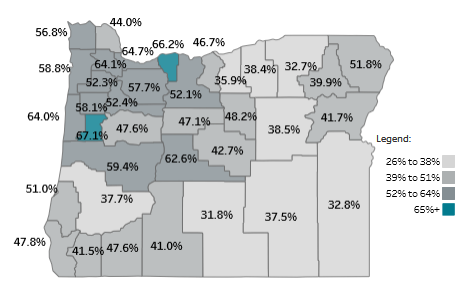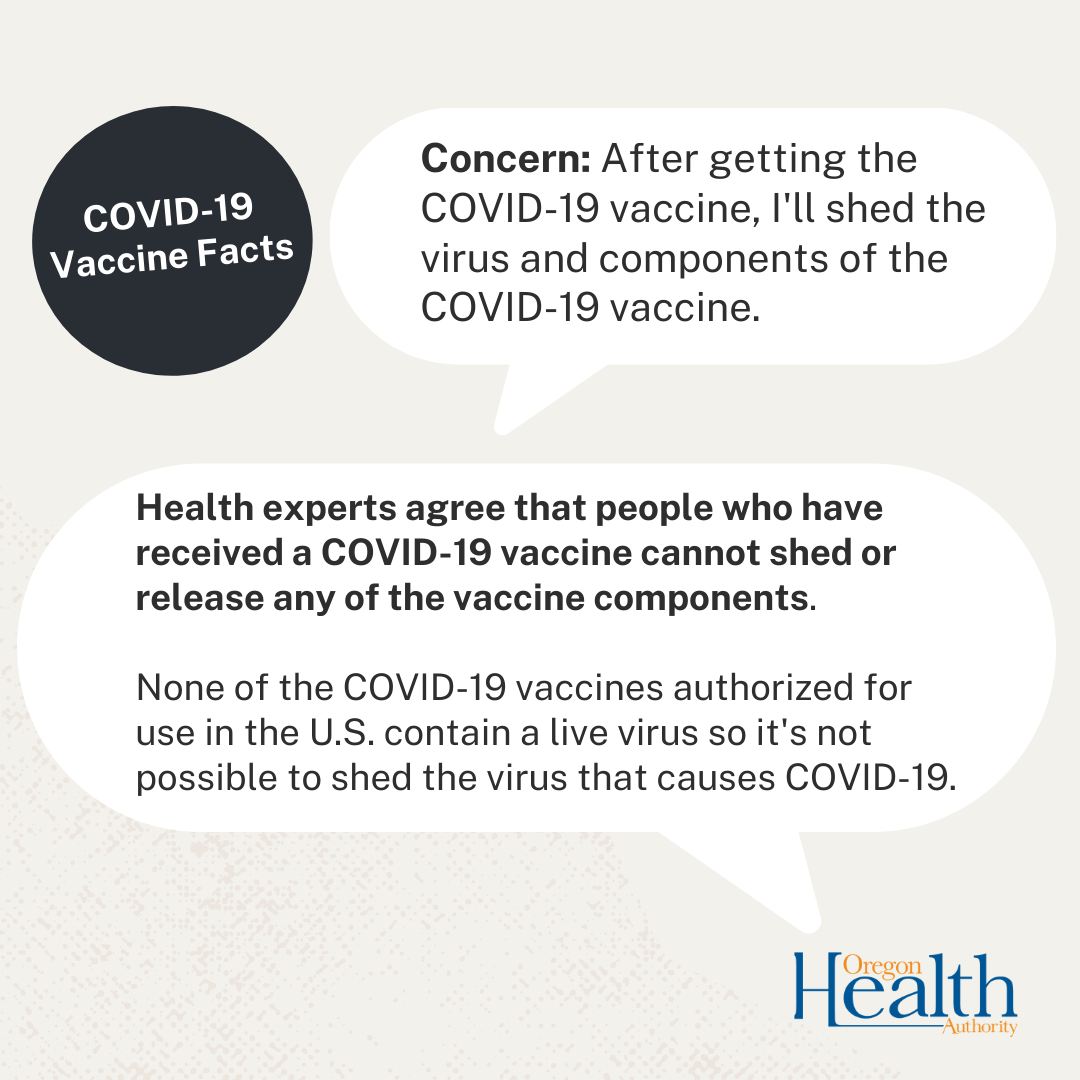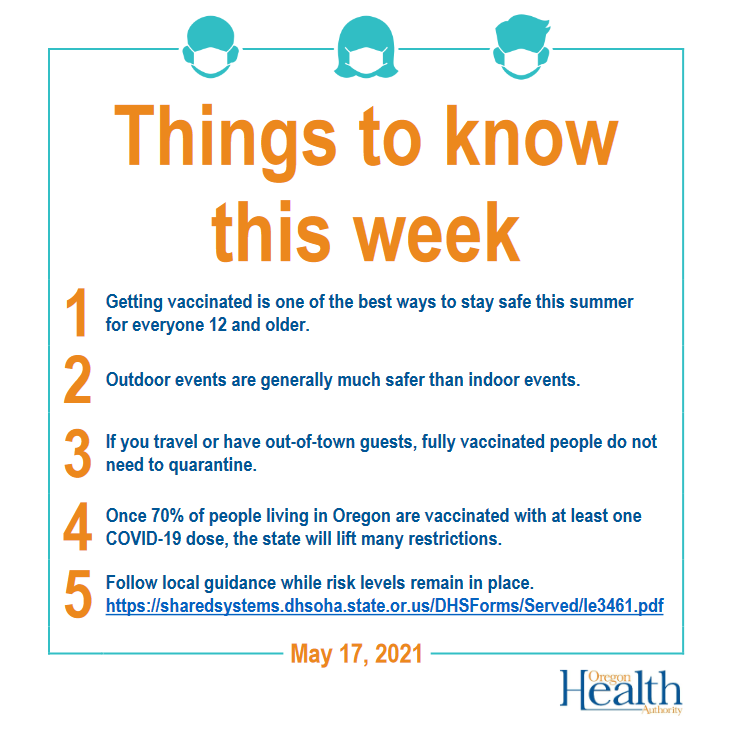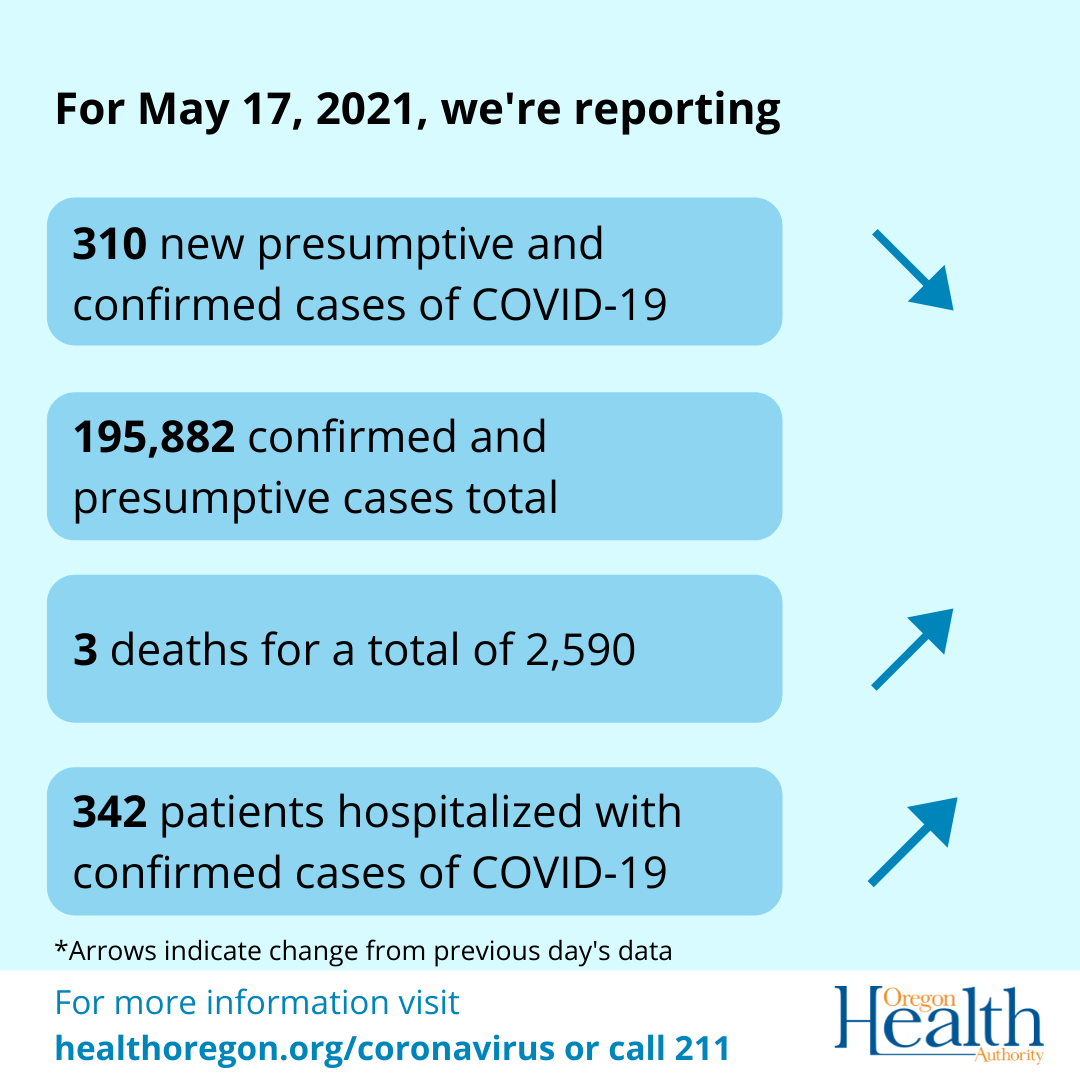 |
May 17, 2021
Celebrate life events in the safest way this summer
Summer is on the way and some of you may be planning to marry, or celebrate an anniversary, graduation, quinceañera, bat mitzvah or other significant event. Celebrating life events in person is something many of us have missed during the COVID-19 pandemic.
With vaccination as a tool for protection, you may be able to start thinking about resuming these celebrations. Once Oregon meets the statewide vaccination target of 70%, many restrictions will be lifted, but hosting the safest event will still require precautions.
Here’s what to keep in mind when planning a summer celebration:
- Outdoor events are generally much safer than indoor events.
- Wearing face coverings slows the spread of COVID-19.
- Limiting capacity to allow for spacing between guests.
- Vaccination reduces the spread of COVID-19 and prevents severe illness and hospitalization in most people.
- Follow local guidance while risk levels remain in place. https://sharedsystems.dhsoha.state.or.us/DHSForms/Served/le3461.pdf
You’ll also need to follow Oregon Health Authority guidance for your event:
- Outdoors in public venues like a garden, follow “Outdoor Entertainment Establishments”.
- Indoor in public spaces, follow “Indoor Entertainment Establishments”.
- In a religious institution such as a temple, mosque, synagogue or church, follow the guidance for Faith institutions.
New dashboard to track Governor’s vaccination goals
When 70% of adults in Oregon receive at least one dose of an authorized COVID-19 vaccine, most pandemic-related restrictions will be lifted statewide.
To visualize the vaccination trend, the Oregon Health Authority (OHA) launched a new dashboard to track statewide and county progress towards Gov. Kate Brown’s vaccination goals.
The new dashboard will display the following:
- The statewide percentage of those 16 and older who have received at least one COVID-19 vaccine.
- The percentage of those 16 and older who have received at least one COVID-19 vaccine in each county.
- The number of people remaining in each county who need to receive a COVID-19 vaccine for the county to reach 65% vaccination in residents 16 years of age and older.
Gov. Brown also announced that beginning May 21, counties will be eligible to move to Lower Risk when 65% of county residents 16 years of age and older receive their first dose of any COVID-19 vaccine and the county submits a plan to close vaccine equity gaps. For more information click here.
Below is a screenshot of the dashboard with data as of 12:01 a.m. on 5/17/2021.
 |
COVID-19 virus cannot be shed after vaccination
Some of you may be wondering if taking the COVID–19 vaccine can cause you to shed the virus that causes COVID-19.
Health experts agree that people who have received a COVID-19 vaccine cannot shed or release any of the vaccine components. In addition, none of the COVID-19 vaccines authorized for use in the United States contain a live virus so shedding the virus is impossible.
Visit the Centers for Disease Control and Prevention (CDC) website to read more about COVID-19 facts.
For help understanding how to find a vaccine in Oregon visit the OHA webpage.

Oregon reports 310 new confirmed and presumptive COVID-19 cases, 3 new deaths
There are three new COVID-19 related deaths in Oregon, raising the state’s death toll to 2,590 the Oregon Health Authority reported at 12:01 a.m. today.
Oregon Health Authority reported 310 new confirmed and presumptive cases of COVID-19 as of 12:01 a.m. today bringing the state total to 195,882.
Vaccinations in Oregon
Today, OHA reported that 23,929 new doses of COVID-19 vaccinations were added to the state immunization registry. Of this total, 16,088 doses were administered on May 16 and 7,841 were administered on previous days but were entered into the vaccine registry on May 16. Cumulative daily totals can take several days to finalize.
The seven-day running average is now 27,611 doses per day.
Oregon has now administered a total of 1,961,954 first and second doses of Pfizer,1,476,963 first and second doses of Moderna and 122,119 single doses of Johnson & Johnson COVID-19 vaccines. As of today,1,591,802 people have completed a COVID-19 vaccine series. There are 2,061,640 who have had at least one dose.
To date, 2,283,255 doses of Pfizer,1,838,040 doses of Moderna and 266,200 doses of Johnson & Johnson COVID-19 vaccines have been delivered to sites across Oregon.
These data are preliminary and subject to change.
OHA’s dashboards provide regularly updated vaccination data, and Oregon’s dashboard has been updated today.
Cases and deaths
The new confirmed and presumptive COVID-19 cases reported today are in the following counties: Baker (1), Benton (7), Clackamas (58), Clatsop (1), Columbia (1), Coos (9), Crook (2), Curry (1), Deschutes (39), Douglas (12), Harney (1), Jackson (6), Jefferson (2), Josephine (3), Lane (27), Lincoln (2), Linn (17), Marion (35), Morrow (2), Multnomah (68), Polk (6), Wasco (3), and Yamhill (7).
Oregon’s 2,588th death is a 91-year-old woman from Jackson County who tested positive on May 5 and died on May 14 at Rogue Valley Medical Center. She had underlying conditions.
Oregon’s 2,589th death is a 71-year-old woman from Deschutes County who tested positive on May 7 and died on May 13 at St. Charles Medical Center Bend. She had underlying conditions.
Oregon’s 2,590th death is a 63-year-old man from Marion County who tested positive on April 20 and died on May 16 at Salem Hospital. He had underlying conditions.
COVID-19 hospitalizations
The number of hospitalized patients with COVID-19 across Oregon is 342, which is three more than yesterday. There are 81 COVID-19 patients in intensive care unit (ICU) beds, which is one fewer than yesterday.
The total number of COVID-19 positive patient bed-days in the most recent seven days is 2,392, which is a 4% increase from the previous seven days. The peak daily number of beds occupied by COVID-19 positive patients in the most recent seven days is 351.
The total number of patients in hospital beds may fluctuate between report times. The numbers do not reflect admissions per day, nor the length of hospital stay. Staffing limitations are not captured in this data and may further limit bed capacity.



